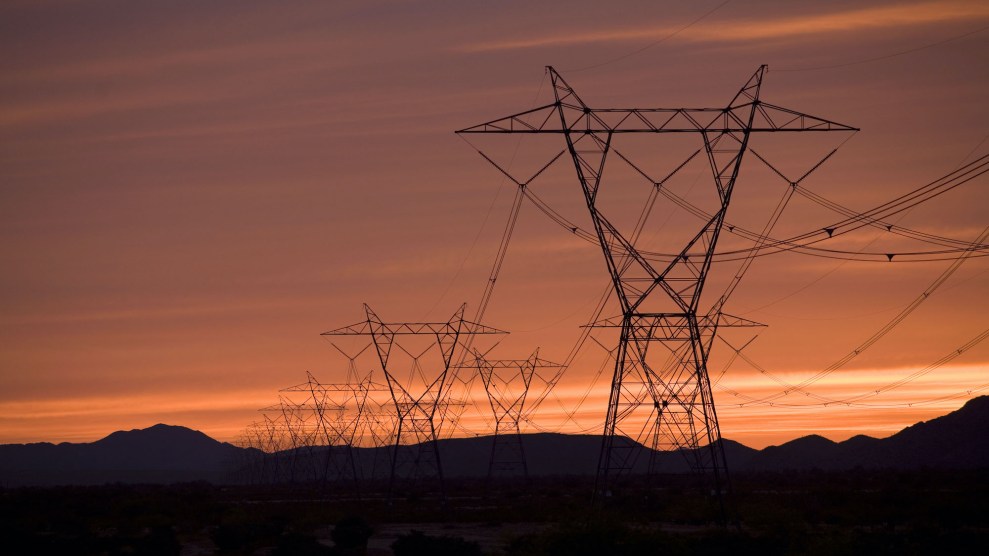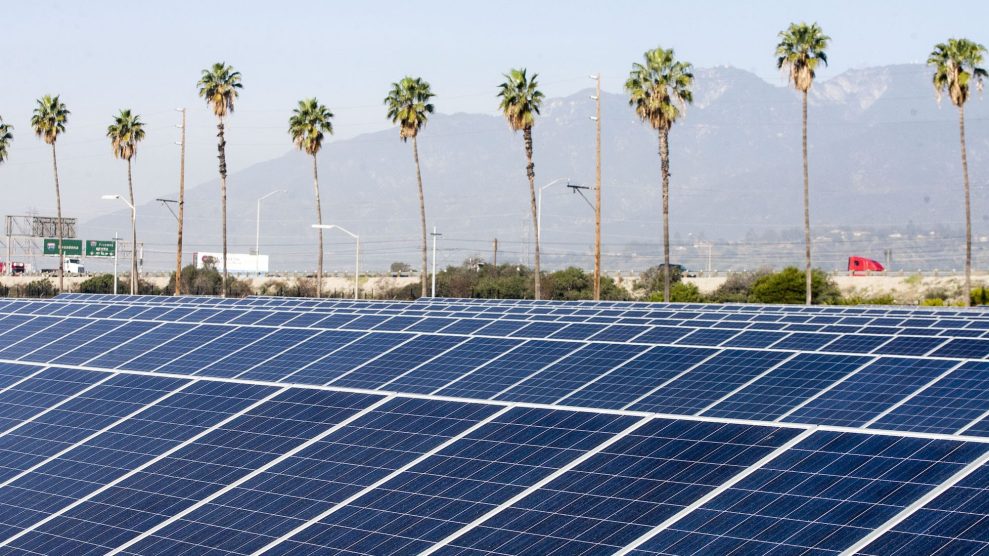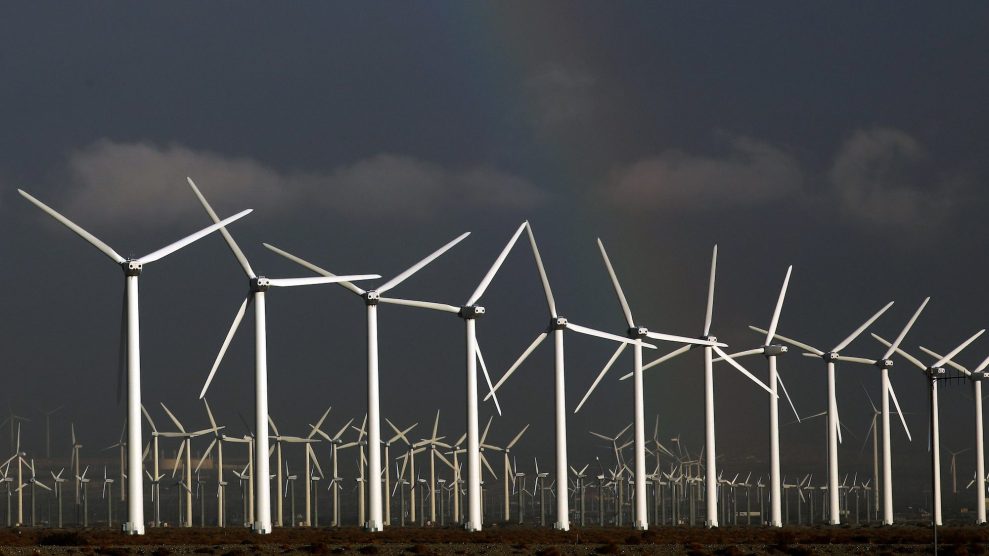
Wind turbines in Walnut, Iowa.Michael Siluk/UCG/Universal Images Group/Getty
This story was originally published by Inside Climate News and is reproduced here as part of the Climate Desk collaboration.
It’s not surprising that gigantic states like Texas and California are among the heaviest hitters in generating electricity from wind and solar. But what if we look at generation per square mile of land?
Then, the leader is Iowa.
Iowa generated 807 megawatt-hours per square mile in 2022 from wind and solar, most of which was from wind, based on data from the Energy Information Administration.
Rhode Island was next with 627 mwh per square mile, most of which was from solar.
Disclosure: I’m an Iowa native and will jump at any opportunity to talk about the virtues of the state. One of my first reporting jobs was covering Iowa politics in the early 2000s.
I got in touch with Josh Mandelbaum, an attorney for the Environmental Law & Policy Center and a member of the Des Moines City Council, to get a better idea of why the state has been so successful at developing wind energy. He credits a 2001 law signed by then-Gov. Tom Vilsack that encouraged utilities to build new power plants by making it easier to obtain regulatory approval to pass the plants’ costs on to customers.
The law helped to set off a construction boom for wind farms, many of them developed by the state’s largest utility, MidAmerican Energy, a subsidiary of Warren Buffett’s Berkshire Hathaway.
“Gov. Vilsack really made a push on renewable energy, and so did Gov. (Chet) Culver after him,” said Mendelbaum, who joined Vilsack’s policy staff after the law passed in 2001.
The state’s support for renewable energy was bipartisan and continued even after Vilsack and Culver, both Democrats, left office. Gov. Terry Branstad, a Republican, was governor from 1983 to 1999 and then had a second stint from 2011 to 2017, and he encouraged wind energy development, as did his successor, current Gov. Kim Reynolds, also a Republican. “Iowa touts its role as an energy provider,” Mandelbaum said.
Just look at the state’s license plate, which includes a silhouette of a wind turbine. Renewable energy has been an economic boon for Iowa, with lease payments that provide additional income for rural land owners and property taxes for local governments. Companies have spent $22 billion to develop wind energy in the state, according to a fact sheet from the Iowa Environmental Council.
But policy support isn’t the main reason for Iowa’s success in wind energy. The main reason is a natural resource—steady wind—that was a nuisance before it turned into a moneymaker.
Iowa is part of a band of states extending from North Dakota and Minnesota in the north to Texas in the south that have some of the best wind resources in the country, as can be seen in maps from the National Renewable Energy Laboratory.
Last year, Iowa’s 44,664 gigawatt-hours of generation from wind farms in 2022 ranked second only to Texas, which was way ahead with 113,880 gwh. (If we look at wind plus solar, Iowa had 45,058 gwh and Texas had 136,118 gwh.)
I wrote last week about how Texas is the country’s leader in renewable and carbon-free electricity generation. And yet, Texas ranks fourth in generation per square mile, behind Iowa, Rhode Island and Oklahoma. (Texas has 4.6 times more land area than Iowa, 253 times more than Rhode Island, and 3.8 times more than Oklahoma.)
Texas also trails in the percentage of its electricity generation that comes from wind and solar, ranking 12th with 26 percent.
Who was number one? It was Iowa, with 63 percent. Next was South Dakota, the only other state to get half of its electricity from wind and solar, with 55 percent, essentially all of it coming from wind.
Not all of that wind energy is getting used in Iowa and South Dakota. The electricity goes into a regional grid that covers much of the Midwest, and gets used wherever it’s needed, which is often in metro areas like Minneapolis-St. Paul.
In recent years, rural communities across the country have been pushing back against renewable energy development, saying that wind and solar are ugly and harm property values. This is happening in Iowa too. And since the state leads the country in wind plus solar generation per square mile, it’s a good place to look at land use concerns.
When I drive on I-80 through the state, there are several stretches in which the horizon is filled with wind turbines, and solar farms are an increasingly familiar part of the landscape.
Several Iowa counties have passed moratoria or other limits on new wind or solar development. State lawmakers have introduced bills that would make it more difficult to get approval to build the projects, but so far none of the measures have passed.
Mandelbaum said the state’s support for renewable energy remains bipartisan, but it’s not as overwhelmingly bipartisan as it was before, with some Republicans wanting to slow development. But he thinks concerns about the amount of wind and solar are at odds with the reality of how much open space the state has.
The main caveat when looking at renewable energy relative to land area is that some states are not well-suited to building wind, solar or both, even if they have a lot of land. For example, California has weak winds across much of its land, while Maine has a combination of rugged terrain and a relative lack of sunshine.
At the same time, Rhode Island ranks high in terms of renewables per square mile, even with very little developable land. The state doesn’t have any solar or wind projects that exceed 50 megawatts of capacity, but that’s about to change. This week, the wind developer Ørsted and the utility Eversource said they have jointly submitted a proposal to build an 884-megawatt offshore wind farm off of the Rhode Island coast, in addition to their existing plan to build a 704-megawatt project in the same area.
“We’re ready to deliver even more good-paying jobs and affordable clean energy to the Ocean State,” said David Hardy, group executive vice president and CEO Americas at Ørsted, in a statement. “And we’re confident that our new proposal will advance Rhode Island’s climate goals while delivering on the promise of a sustainable economic engine rooted in thriving port facilities and powered by local union labor.”
The lower end of first chart also tells a story. It’s not a surprise to see Alaska at the bottom, considering its vast land area. The others are a tour of underachievement in the South, as Kentucky and Louisiana sit just above Alaska.
Kentucky and Louisiana both have some big solar projects that will be coming online, so their renewable energy generation is set to increase—but they have a lot of catching up to do to even get close to average. Meanwhile, Iowa continues to be a leader.
















